Chord Formulas
Have you ever wondered what makes a Major chord Major, or a Minor chord Minor?
This tutorial will go over a few of the chord formulas, but more importantly, it will show you have to figure out the notes of any chord you come across.
This section is more theory than actual playing the guitar.
Here we will explain how chords are created. It's a subject that most people skip over, but it is very important to be able to figure out any kind of chord on your own, without looking at a chord chart, or buying a chord book.
This section will give you the basic information that you will use to fully understand my web tool, "Find The Notes On the Fretboard", which can be accessed in the top menu.
What is a scale?
The definition is: A scale is simply a way of ordering the twelve sounds found in Western Music.
Ok, what does that mean?
A scale contains notes between one octave and another.
For example, the E chromatic scale contains EVERY NOTE between one E and another E an octave higher.
Those notes are: E, F, F#, G, G#, A, A#, B, C, C#, D, D#
Scale patterns are based on Whole (W) or half (H) steps from one note to another.
The chromatic scale's pattern is simply move up a half step from the previous note.
So, it's pattern is: HHHHHHHHHHHHH
Here is how the Chromatic Scale looks on the fretboard.
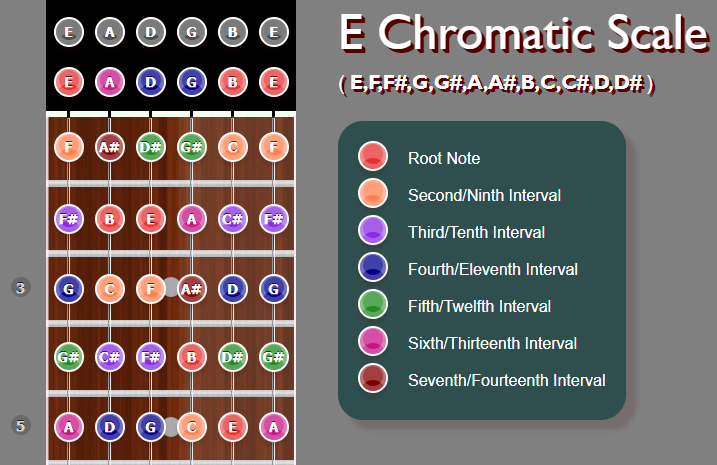
There are many different types of scales. Most contain 7 notes, others contain more or less.
Thankfully, we will only need to know one scale pattern for our chord formulas...
The Major Scale Pattern
The Major Scale's pattern is W-W-H-W-W-W-H
All chords are based on the Major Scale. Any A chord, is based on the A Major scale.
Any C chord, is based on the C Major scale, and so on.
As stated many times before, the guitar is filled with repeatable patterns.
Here is the pattern for the Major Scale on the guitar.
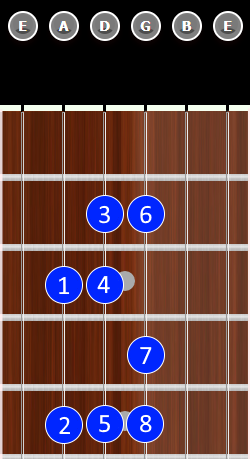
When first learning it, while practicing it, it is more important to count the numbers as you play it,
rather than knowing the notes. That will come, with time, but this pattern will help you more in the beginning.
The ROOT NOTE is the ONE. The OCTAVE is the 8. So, in the above graphic, the ONE starts on the A string, 3rd Fret, so, this is a C Major Scale.
This pattern works all the way up and down the fretboard, as long as the root note is on the E (6th) or A (5th) string.
It only works there because it spans 3 strings. If we go further than the G string, the tuning changes,
because the B string is tuned at the 4th fret of the G string (B note), all the other strings at the 5th fret.
Moveable Pattern
The C Major Scale has no flats or sharps.
So, when you run this pattern, starting on the A string, 3rd fret, we start with a C root note.
This gives us the C Major Scale. Here are the notes of a C Major Scale in the pattern:
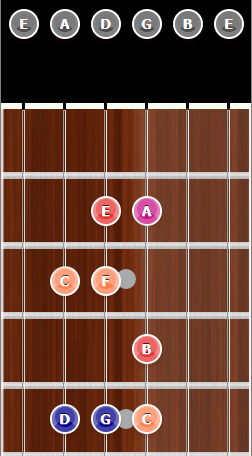
If we want the A Major Scale Pattern, we simply start it on the 5th fret of the E string.
The reason we start on the 5th fret, E string and not the open string is that some of the notes in the pattern are one fret lower than the root. If the root is open, we can't go lower.
E string, 5th fret, gives us the A Major Scale. Here is the same pattern, with an A root note:
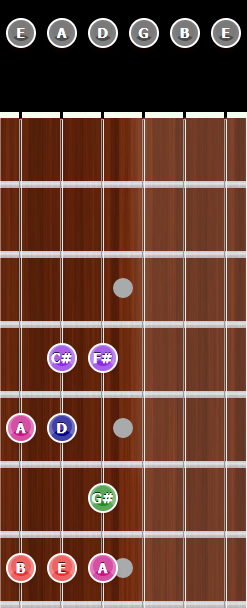
This pattern can be moved anywhere up and down the neck with the root on the Low E or A strings.
Major Chord Formula - [1, 3, 5]
The chord formula for the Major Chord is the 1 - 3 - 5 notes of the Major Scale.
So, we take out Major Scale Pattern, and put the root on the A string 3rd fret for the C note:

Here are the notes of the C Major Scale, using our pattern:

The 1, root is the C note.
The 3 is the E.
The 5 is the G.
So, the C Major Chord consists of: C - E - G.
To verify, we check against the well known open C Major Chord.
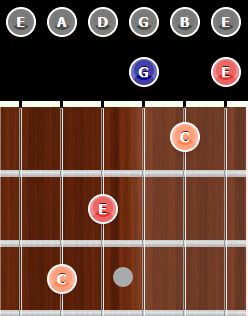
We confirmed that the notes of the C Major Chord are : C - E - G in the open C Chord.
We'll do another major chord to further solidify your understanding.
Major Chord Formula - [1, 3, 5] (cont.)
Next, we will find the notes of the A Major Chord.
Moving our pattern to the 5th fret, 6th string, we now have the A Major Scale.
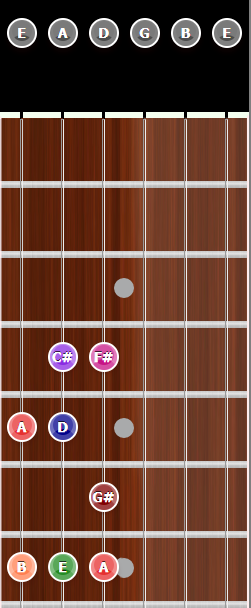
The Major Chord is made up of the 1-3-5 of the Major Scale. Going through the scale pattern again,
The Root: A
The Third: C#
The Fifth: E
So, our A Major Chord contains the following notes: A - C# - E
Once again, we verify it with an open A Major Chord.
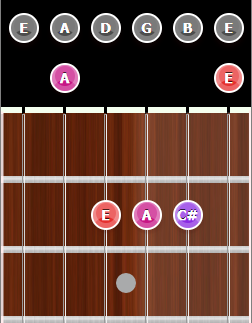
As you can see, we have confirmed that the notes of an A Major Chord are: A - C# - E
Minor Chord Formula - [1, b3, 5]
As with the Major Chord, we base the minor chord on the same Major Scale.
The difference is now we have to "flatten" the 3rd. Which simply means lower it by a half step (one fret)
Here we flatten the 3rd (bring it down a half step):

Here is the the scale with the 3rd flattened:
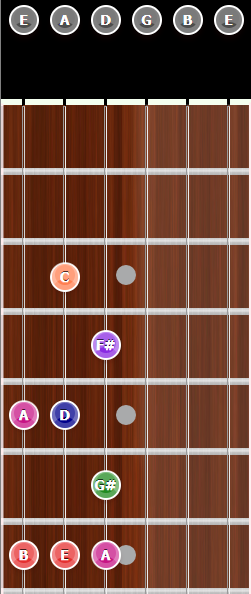
Now all we have to do is get the root, the flattened 3rd, and the 5th from the above scale.
This shows that A Minor has the following notes: A - C - E
Again, we verify it with our open A Minor Chord.
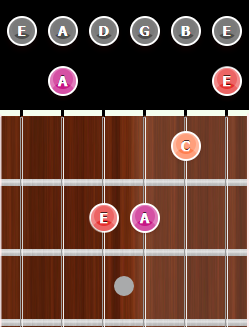
This confirmed that we have the correct Minor Chord Formula.
Major 7th Chord [ 1 - 3 - 5 - 7 ]
For this example, we'll look at the A Major 7th (AMaj7) Chord. Once again, we check the A Major scale.

Now, we already know that the Major Chord is made with: A - C# - E
We now need to add the 7th to it. Check the A Major Scale pattern to find that 7th.
Looking at our Major pattern, we find that the 7th of the A Major Scale is G#.
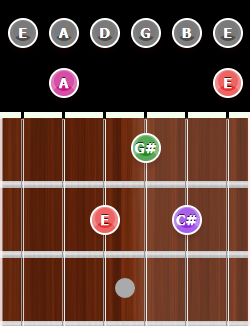
Minor 7th Chord [ 1 -b3 - 5 - b7 ]
For our final example, we use the A Major Scale, and flatten the 3rd and 7th.
In the A Minor 7th Chord, the notes are: A,C,E,G
Here is an A Minor 7th Chord to verify our findings.

Other Scale Formulas:
- Suspended Second = 1 - 2 - 5 | Csus2
- Suspended Fourth = 1 - 4 - 5 | Csus4
- Added ninth = 1 - 3 - 5 - 9 | Cadd9
- Diminished = 1 - b3 - b5 - b7
There are MANY more chord formulas. This was just a very small set to get you started.
Wrap Up
Unlike other tutorials, it was not meant to show you some chords.
The purpose of this section was to teach you how chords are created,
and give you the tools you will need to break down ANY chord formula.
NOTE: If a number is higher than the octave (8), just delete 7 from it, and figure out the notes of the chord. So, a 9th is the same note as a 2nd, and so on.
For example: Amaj7#11
Now you know how to break this chord down, and you would find that
the notes of Amaj7#11 are : A - C# - E - G# - D#